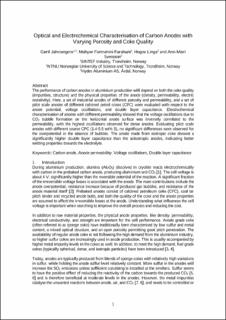| dc.contributor.author | Jahrsengene, Gøril | |
| dc.contributor.author | Farahani, Mahyar | |
| dc.contributor.author | Linga, Hogne | |
| dc.contributor.author | Svensson, Ann Mari | |
| dc.date.accessioned | 2023-03-01T13:36:51Z | |
| dc.date.available | 2023-03-01T13:36:51Z | |
| dc.date.created | 2022-12-01T09:13:45Z | |
| dc.date.issued | 2022 | |
| dc.identifier.citation | Light Metals, Part of the The Minerals, Metals & Materials Series. 2022, 843-850. | en_US |
| dc.identifier.issn | 2367-1181 | |
| dc.identifier.uri | https://hdl.handle.net/11250/3055048 | |
| dc.description.abstract | The performance of carbon anodes in aluminium production will depend on both the coke quality (impurities, structure) and the physical properties of the anode (density, permeability, electric resistivity). Here, a set of industrial anodes of different porosity and permeability, and a set of pilot-scale anodes of different calcined petrol cokes (CPC) were evaluated with respect to the anode potential, voltage oscillations, and double-layer capacitance. Electrochemical characterisation of anodes with different permeability showed that the voltage oscillations due to CO2 bubble formation on the horizontal anode surface was inversely correlated to the permeability, with the highest oscillations observed for dense anodes. Evaluating pilot-scale anodes with different source CPC (1.4–5.5 wt% S), no significant differences were observed for the overpotential in the absence of bubbles. The anode made from isotropic coke showed a significantly higher double-layer capacitance than the anisotropic anodes, indicating better wetting properties towards the electrolyte. | en_US |
| dc.language.iso | eng | en_US |
| dc.publisher | Springer | en_US |
| dc.subject | Double layer capacitance | en_US |
| dc.subject | Voltage oscillations | en_US |
| dc.subject | Anode permeability | en_US |
| dc.subject | Carbon anode | en_US |
| dc.title | Optical and Electrochemical Characterisation of Carbon Anodes with Varying Porosity and Coke Quality | en_US |
| dc.title.alternative | Optical and Electrochemical Characterisation of Carbon Anodes with Varying Porosity and Coke Quality | en_US |
| dc.type | Peer reviewed | en_US |
| dc.type | Journal article | en_US |
| dc.description.version | acceptedVersion | en_US |
| dc.rights.holder | This is a post-peer-review, pre-copyedit version of an article published in Light Metals 2022, Part of the The Minerals, Metals & Materials Series book series (MMMS). The final authenticated version is available online at: https://doi.org/10.1007/978-3-030-92529-1_111 | en_US |
| dc.source.pagenumber | 843-850 | en_US |
| dc.source.journal | The Minerals, Metals & Materials Series | en_US |
| dc.identifier.doi | 10.1007/978-3-030-92529-1_111 | |
| dc.identifier.cristin | 2086631 | |
| cristin.ispublished | true | |
| cristin.fulltext | original | |
| cristin.fulltext | postprint | |
| cristin.qualitycode | 1 | |
